Art Fairs
Back After the Hurricane, Puerto Rico’s MECA Art Fair Is Making Its Mark Through Pure Enthusiasm
After Hurricane Maria, the fair took a pause but pushed on. It was worth the extra wait.
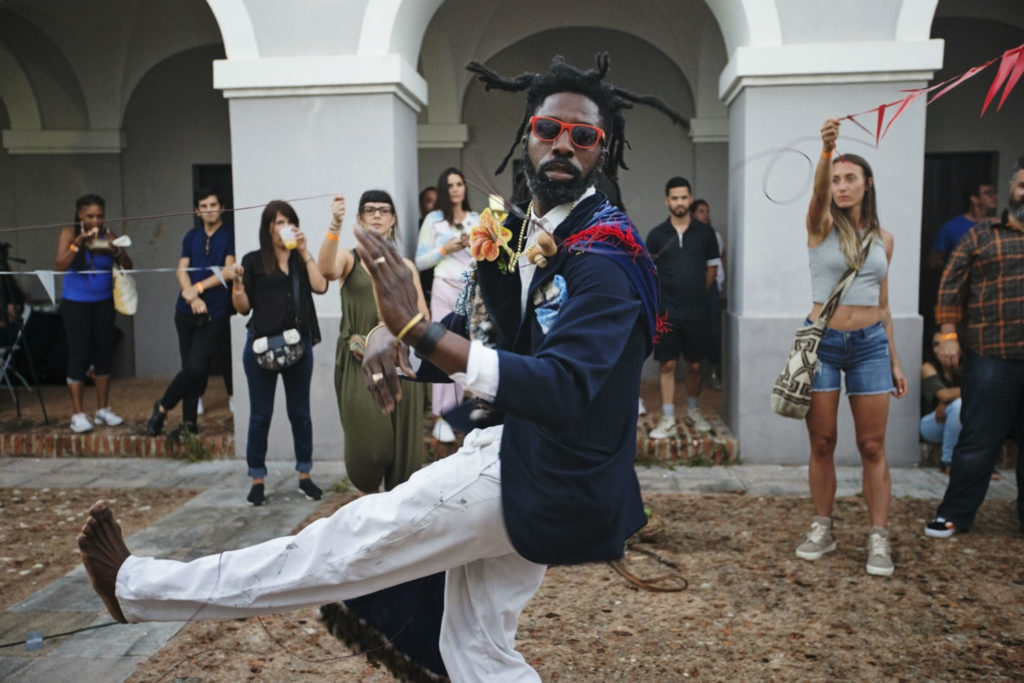
After Hurricane Maria, the fair took a pause but pushed on. It was worth the extra wait.

Jasmin Hernandez

MECA international art fair persists no matter what you throw at it.
The budding contemporary art fair launched last June, one month after Puerto Rico declared a form of bankruptcy. It returned this month, November 16-19, 2018, in Old San Juan, fourteen months after the island-wide disaster of Hurricane Maria. In the face of all this, what does this small but mighty fair have to offer?
During the final day of the 2018 edition, on a sweltering Monday afternoon, I sat down with MECA’s co-founders Danny Báez and Tony Rodríguez, in a cool air-conditioned spot within the fair. The two unpacked the lessons of their second go-around.
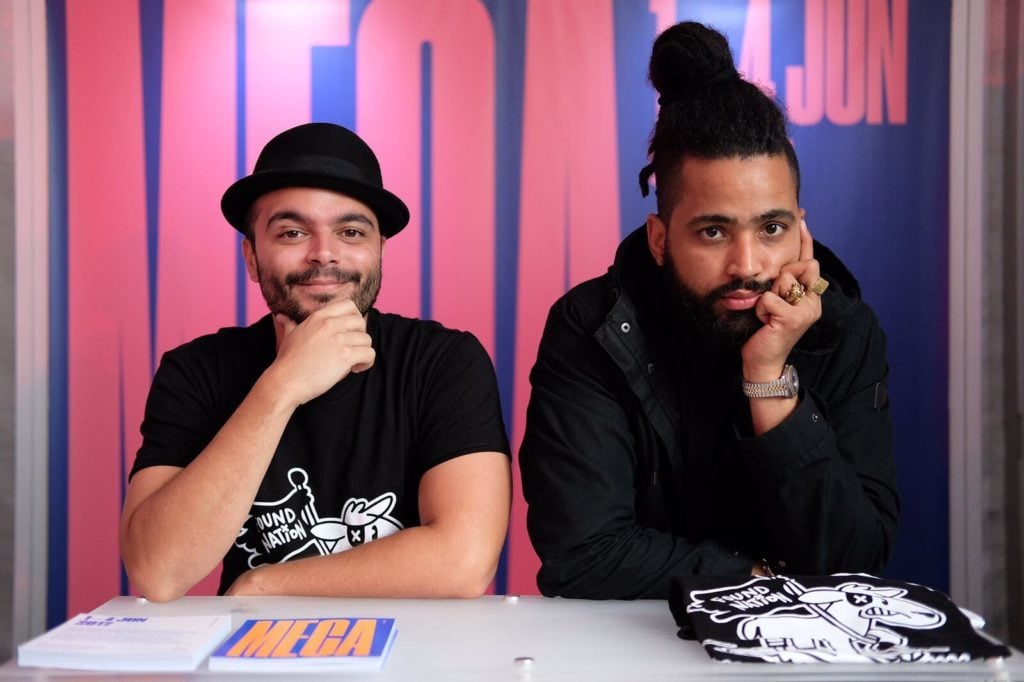
Tony Rodríguez and Daniel Báez, co-founders of MECA. Courtesy of MECA International Art Fair. Photo courtesy Eric Rojas.
How does MECA push on despite facing the near-impossible circumstances? “Honestly, right now, this is a passion project. We know that in order for it to happen we have to take risky decisions,” Rodríguez stated. “Right now our heads are on a guillotine—it’s lot of pressure because you have to find the guts to do it. This year, it was very important to do, after the hurricane. It’s not a capricho [whim]—this is serious.”
Hurricane Maria wreaked havoc on Puerto Rico’s infrastructure, leaving the whole island with flooding, lack of power and water, and at the mercy of negligent relief efforts. Adjusting, MECA took a beat and decided to return in November instead of June, to allow for needed recovery.
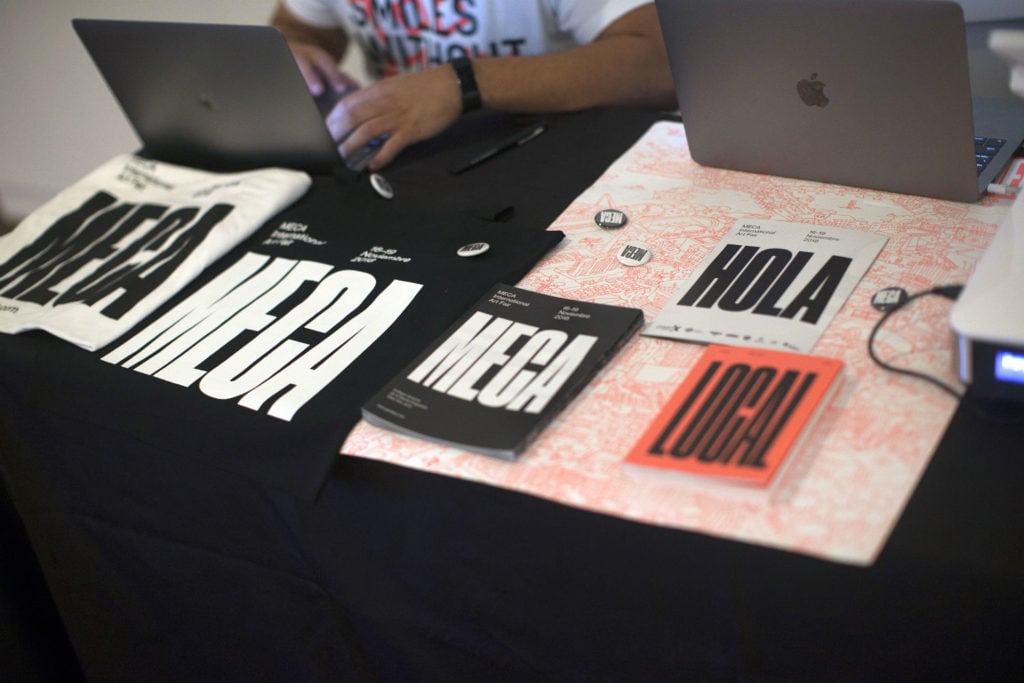
Atmosphere at the MECA art fair. Image courtesy MECA.
Despite the historic damage, the mood post-Maria is upbeat and optimistic. As I engaged with chauffeurs, hotel staff, restaurant servers, and local artists during my four-day stay in Condado and Old San Juan, almost everyone expressed hope for the future.
Báez and Rodríguez say that their major issues with MECA had little to do with the fallout from the hurricane, and more to do with the generally dubious position of an art fair here.
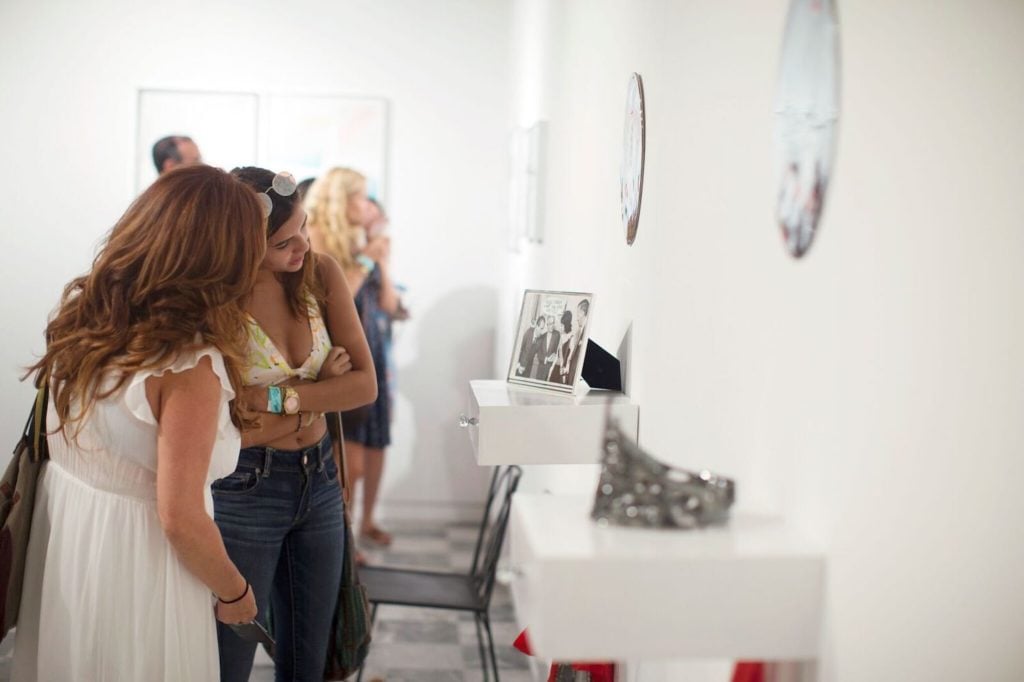
Visitors look at work at Fierman gallery. Image courtesy MECA.
“The obstacles we face are educating people: ‘What is this?’, ‘What is an art fair?’, ‘Why are galleries coming to Puerto Rico?’,” Rodríguez asserts.
“We are creating a market because it doesn’t exist. We—at least Tony and myself—don’t come from privilege. Everything has come from our pockets. We managed to finance the fair with the incoming payments from the galleries,” Báez explains.
Báez says that there has been a little bit of aid from Puerto Rico’s government, but the Tourism Department is the only branch that has thrown any support to MECA, which is currently the only international art fair in the Caribbean.
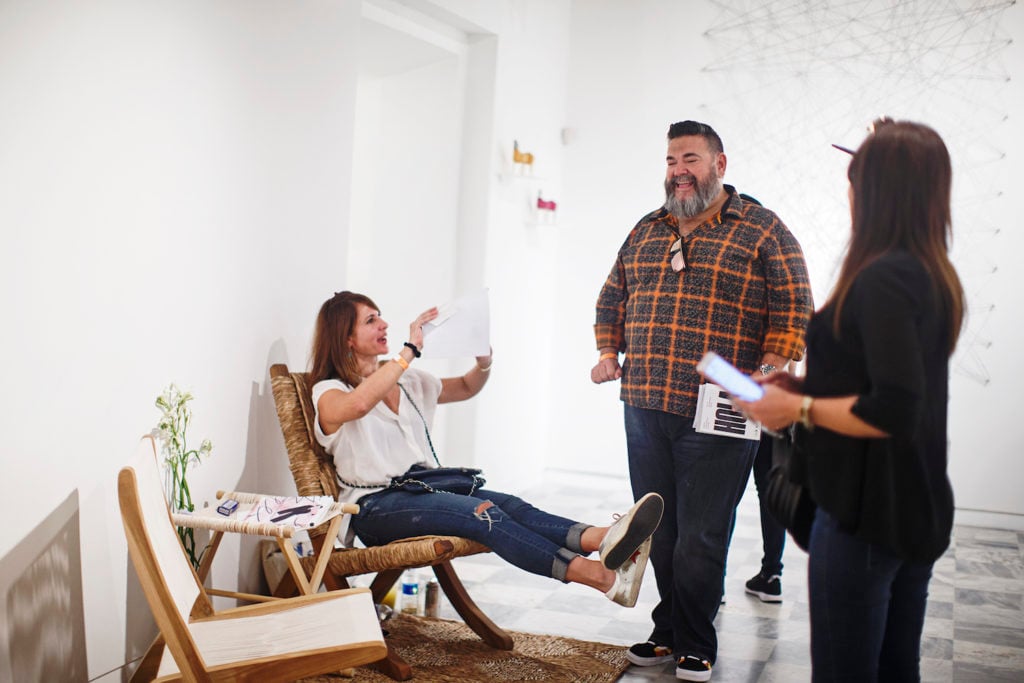
The booth of Embajada gallery during MECA. Image courtesy MECA.
Báez, a native of Santo Domingo, Dominican Republic, and Rodríguez, a native of Bayamón, Puerto Rico, met in 2015 at the Argentine art fair arteBA, where Rodríguez was showing as an artist and Báez was attending as a Latin American liaison for Gavin Brown’s Enterprise. A friendship blossomed, and the seed of MECA was planted.
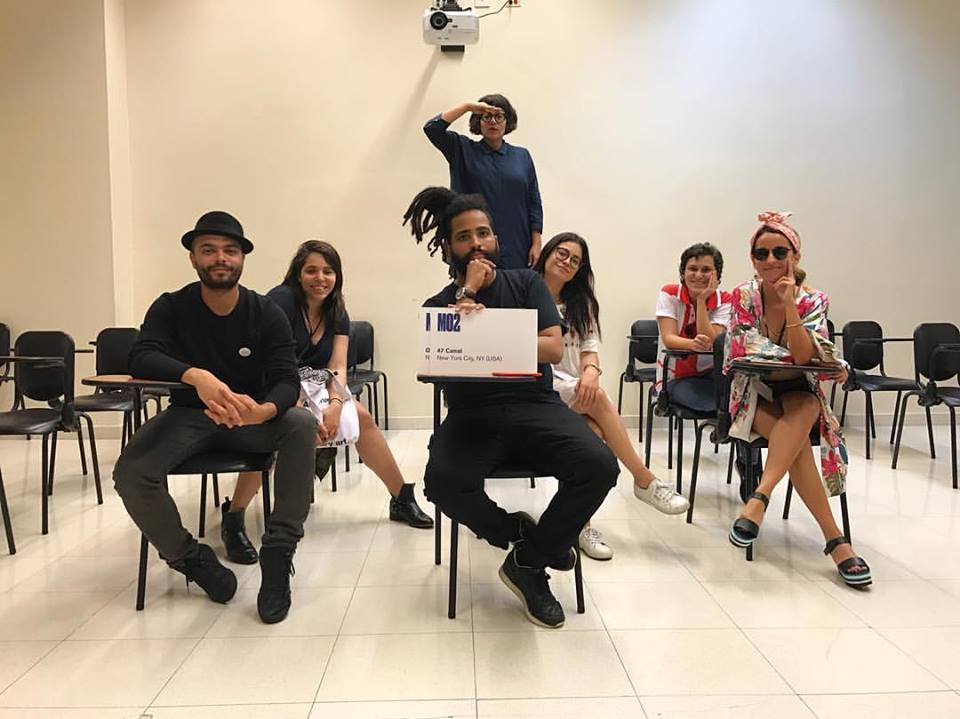
The MECA art fair team. Image courtesy MECA.
Additionally, the fair is supported by four amazing women in the arts: Mariángel Catalina Gonzales, MECA’s senior producer; Hazel Colón, MECA’s cultural director and development strategist; María Frederique, director of business development and strategy; and Laura Rentas, MECA’s PR director. All are part of the fair’s executive team and advise on key decisions.
MECA returned with a bang during its four-day run, with attendance rising for the second edition to 4,500 from 3,000 in 2017. The fair has several potential advantages going for it, despite Puerto Rico’s recent difficulties. For one, it is scheduled two weeks before Art Basel in Miami Beach, making it another tropical art getaway on the art calendar. It’s also situated in Puerto Rico, serving as a gateway to the Caribbean and Latin America but still in the US, which eases logistics.
MECA also changed venues this year, leaving the Puerto Rico Conservatory of Music in Santurce for the historic Antiguo Arsenal de la Marina Española, an old Spanish fortress that serves as a year-round art gallery, located in picturesque Old San Juan. The location is stunning, located on the water surrounded by manicured gardens.
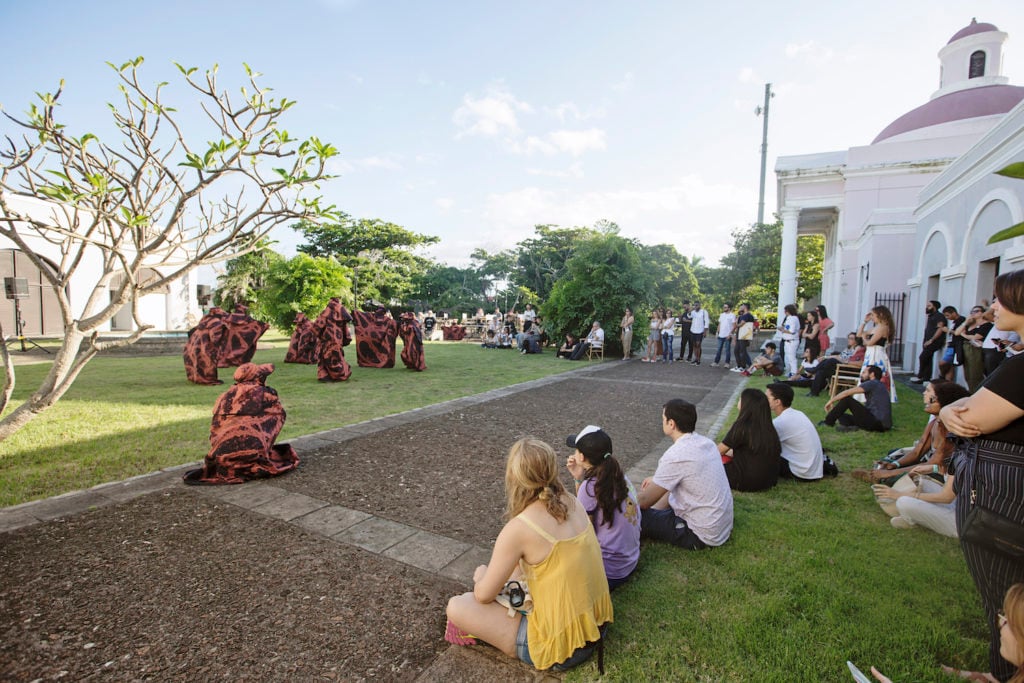
Performance by Alexandre Bavard and Trinchera Danza during MECA. Photo by Raquél Pérez Puig. Image courtesy MECA.
“I think changing the venue to Old San Juan was an asset, because of its pedestrian streets,” Rodríguez shares. “You can leave the fair, have a coffee, visit El Morro [a 16th-century citadel and heritage site]. People are happy with that, because Old San Juan is beautiful. Also many people had never visited this building—even locals living in Puerto Rico never even knew it existed.”
As an additional attraction, this year the inaugural MECA Art Talks were held at Museo de Arte de Puerto Rico. Speakers included musician and designer Raquel Berrios; Pierre Serrao, of the “culinary collective” Ghetto Gastro; consultant and curator Jae Joseph; and Kickstarter’s Patton Hindle.

Inside the MECA art fair. Image courtesy MECA.
A plethora of reputable New York galleries such as 47 Canal, Bridget Donahue, White Columns, and Gavin Brown’s Enterprise exhibited this year at the invite-only fair, alongside local San Juan spaces like Embajada and National, as well as Karen Huber from Mexico City, and Casa Quien from Santo Domingo, Dominican Republic.
At Karen Huber’s fluorescent booth, Puerto Rican Pop artist Hector Madera, based in Mexico City, showed off his mutated pop-culture references, e.g. two palm trees and a Nike swoosh arranged to resemble a happy face emoji.
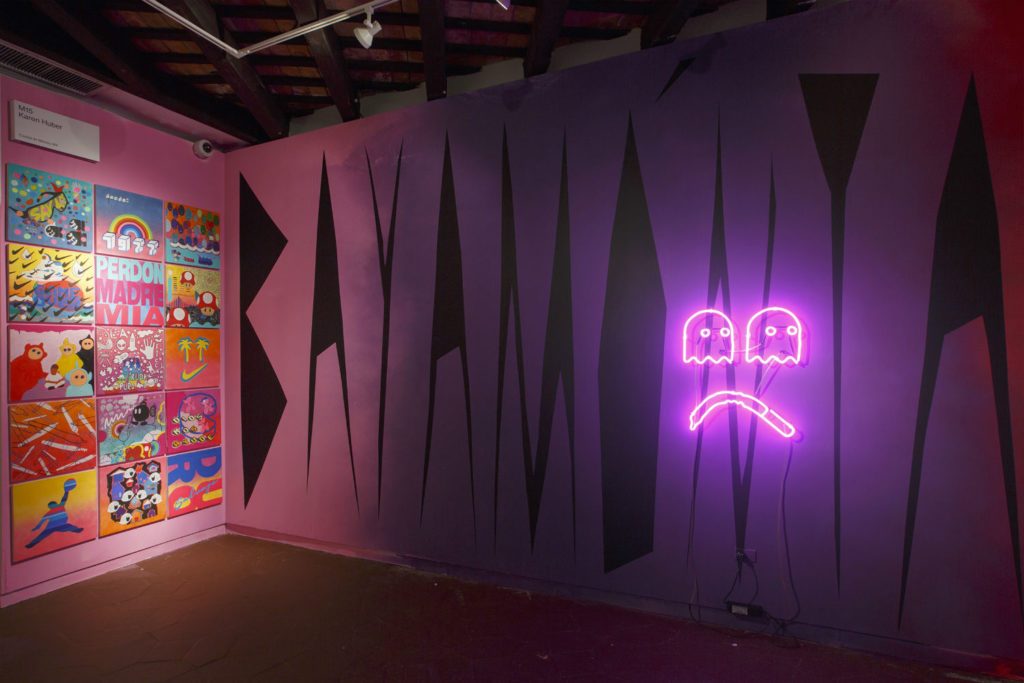
Installation view of works by artist Hector Madera by Karen Huber gallery. Image courtesy MECA.
LatchKey Gallery exhibited the young Salvadoran-American painter and SVA student John Rivas, who makes colorful and vulnerable portraits paying homage to family members and his ancestral roots.
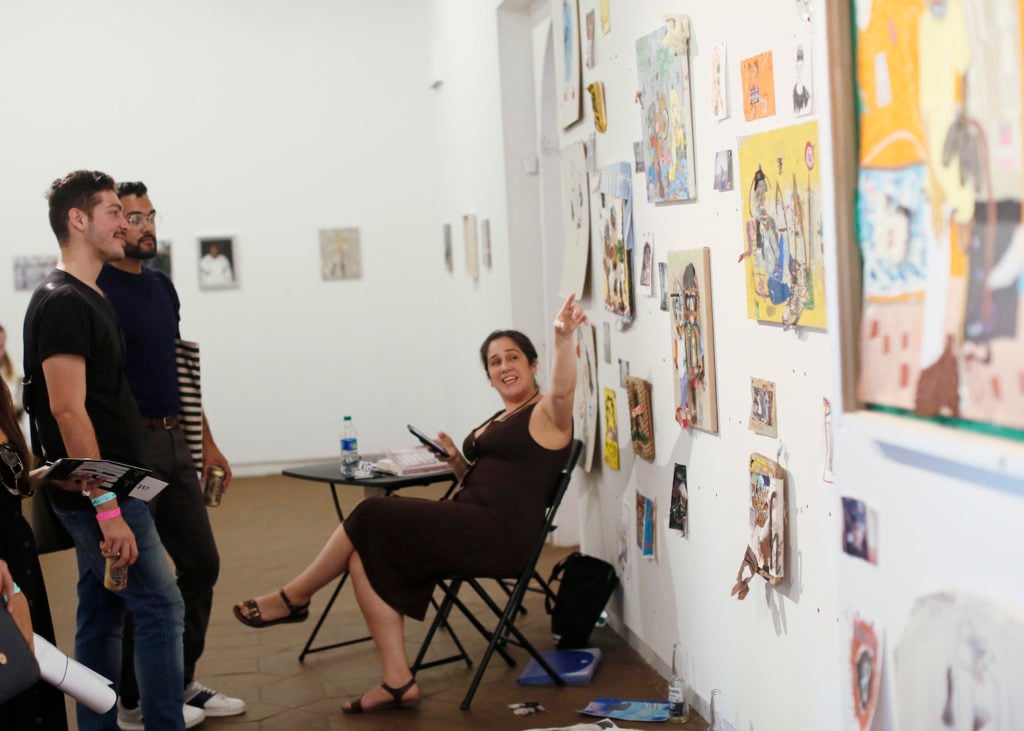
Showing the works of John Rivas at LatchKey Gallery. Image courtesy MECA.
White Columns returned to MECA with the touching self-portraits of the late self-taught Brooklyn artist Derrick Alexis Coard, who was of Caribbean heritage. The young artist was diagnosed with schizophrenia and passed away unexpectedly in 2017.
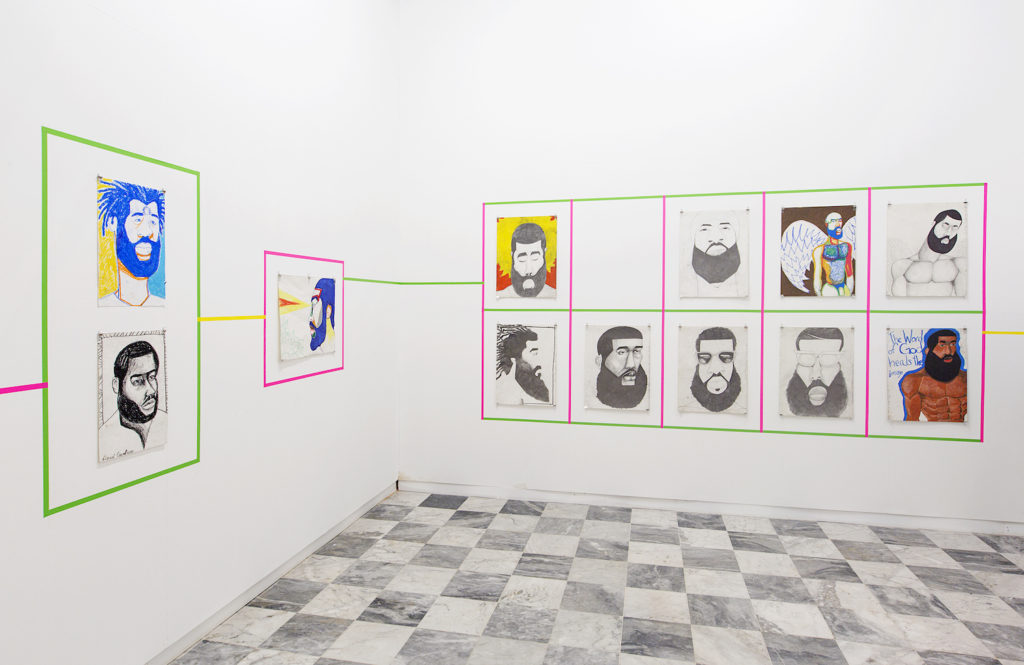
Works by Derrick Alexis Coard at White Columns. Image courtesy MECA.
Matthew Higgs, White Columns’s executive director, is a fan of the new fair: “MECA’s focus on the expanded Caribbean region is a compelling narrative, a focused platform that provides White Columns with an opportunity to share aspects of our mission and programs with new audiences,” he wrote in an email.
MECA Special Projects, dispersed around the fair, featured curator/artist collaborations displaying both mid-career and established Puerto Rican artists. Among these, Bobby Cruz, a sculptor and painter with Galería Petrus, presented humorous neon sculptures of lemon and water drop emojis layered over abstract canvases.
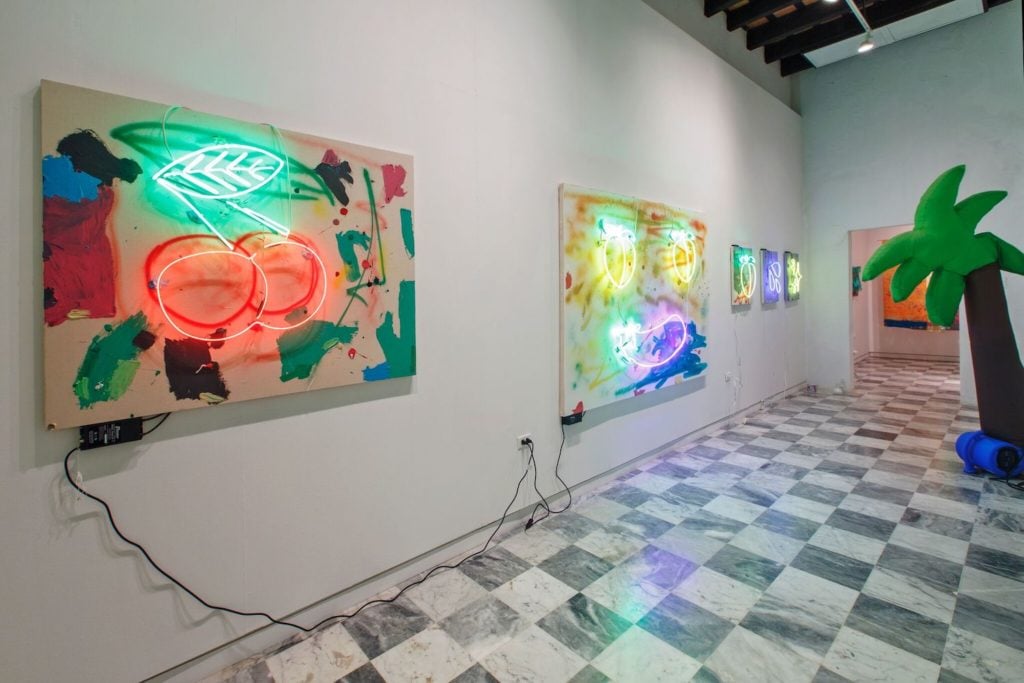
Installation view of Bobby Cruz at Galería Petrus. Image courtesy MECA.
Carlos Mercado’s Art is my Religion, was an epic installation experience and an ode to divinities of all sorts. Viewers entered a small chapel on the grounds of the marina to the sounds of monks chanting and the sight of neon-colored religious figures, including St. Francis of Assisi and the Buddha.
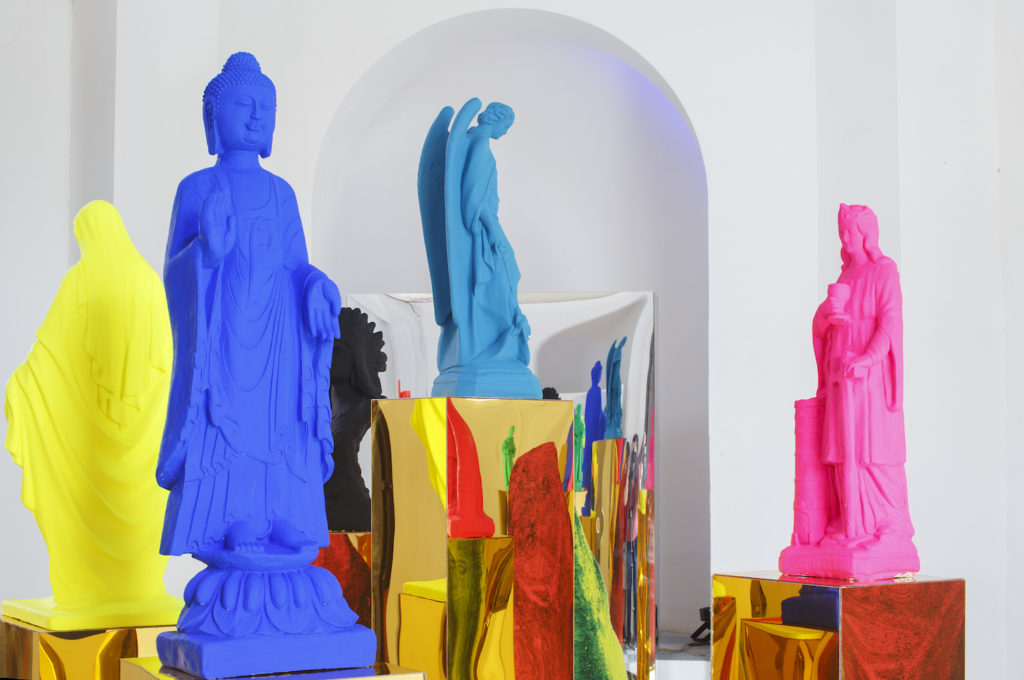
Installation view of Carlos Mercado’s Art is my Religion. Image courtesy MECA.
An anchor of the fair was MECANISMOS, a space for young artists to exhibit projects they were developing, selected by Carla Acevedo-Yates. These included Nyugen Smith and Alexandre Bavard, among others.
There, a standout was undoubtedly FEMTRAP by artist and muralist Sofia Maldonado, a New York- and Puerto Rico-based artist who explores feminism within hip-hop and reggaeton culture. FEMTRAP, which emerged from a year-long process of research and making, included a video projection, limited-edition merch, and small drawings.
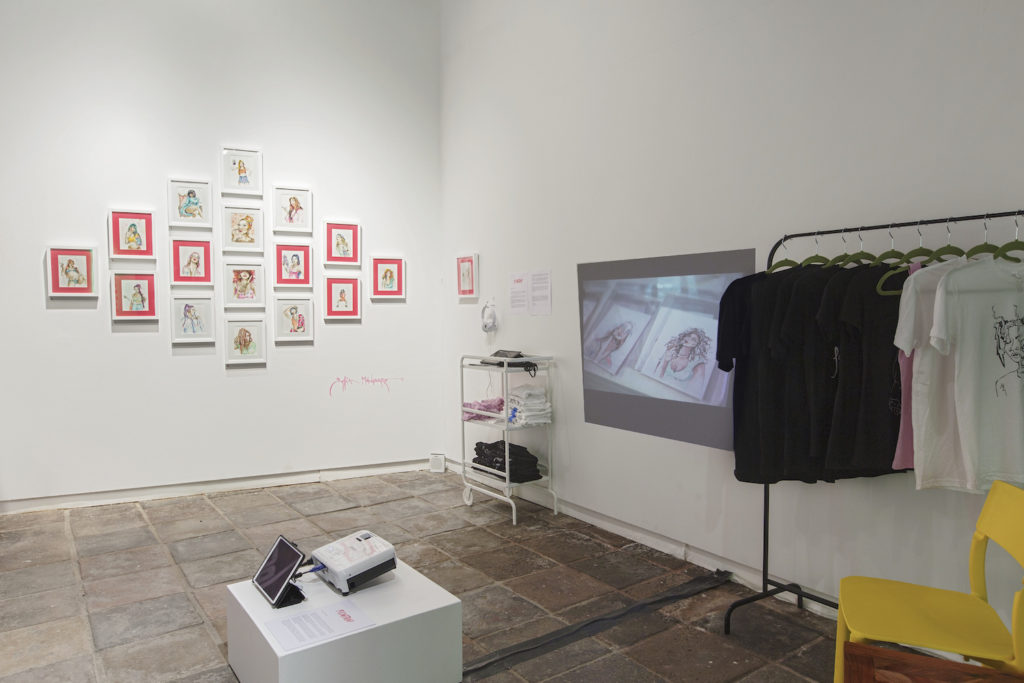
Installation view of Sofia Maldonado’s FEMTRAP. Image courtesy MECA.
The small works on paper, inspired by Latinx female trap singers, depict bold, colorful, audacious women, carrying guns, holding knives, or smoking weed. In an email, Maldonado wrote that she hoped the innovative installation “allows the viewer to have a conversation with the drawings.”
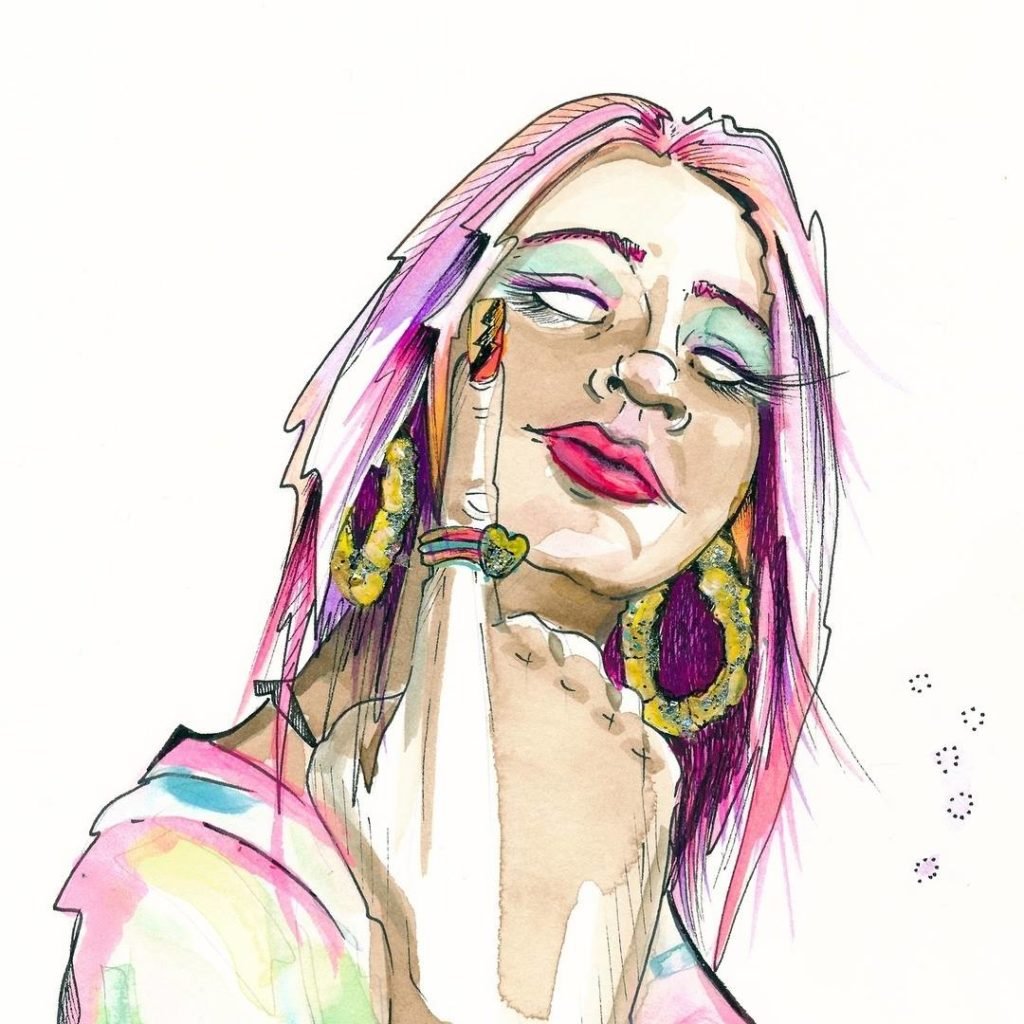
Image from Sofia Maldonado’s FEMTRAP series. Image courtesy MECA.
But the heart and soul of MECA art week may not have been the fair itself, but the satellite programming in Old San Juan and Santurce. Beyond the main fair, grassroots spaces in these neighborhoods took advantage of MECA’s presence and engaged new audiences.
For the past five years, the artsy neighborhood of Santurce has been bubbling with alternative art spaces and stylish restaurants. (Rodriguez, an artist and former gallery owner, himself operated the former Espacio 20/20 on Calle Cerra.)
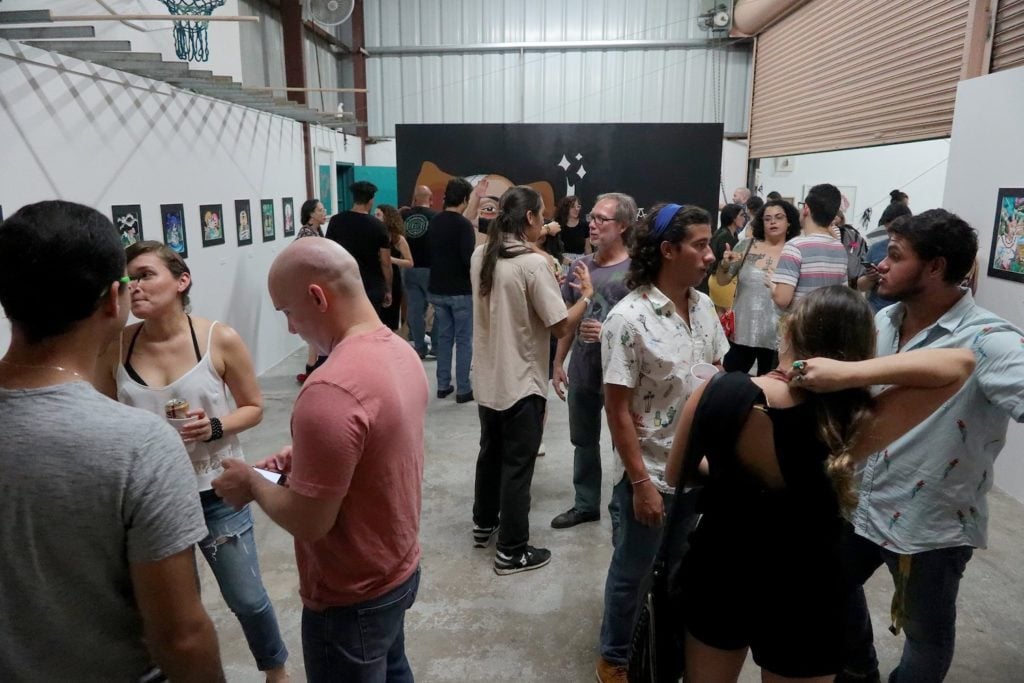
Installation view of the opening of Elizabeth Barreto at Taller Malaquita. Image courtesy Doel Vázquez Pérez.
During the fair, the female-run workshop and collective Taller Malaquita on Calle Condado hung from the ceiling the flags of Puerto Rico, Cuba, Dominican Republic, and Haiti, to show pan-Caribbean solidarity. Two of the women who operate the space, Zuania Minier and Rosenda Alvarez Faro, introduced me to their show of Elizabeth Barreto’s feminist illustrations.
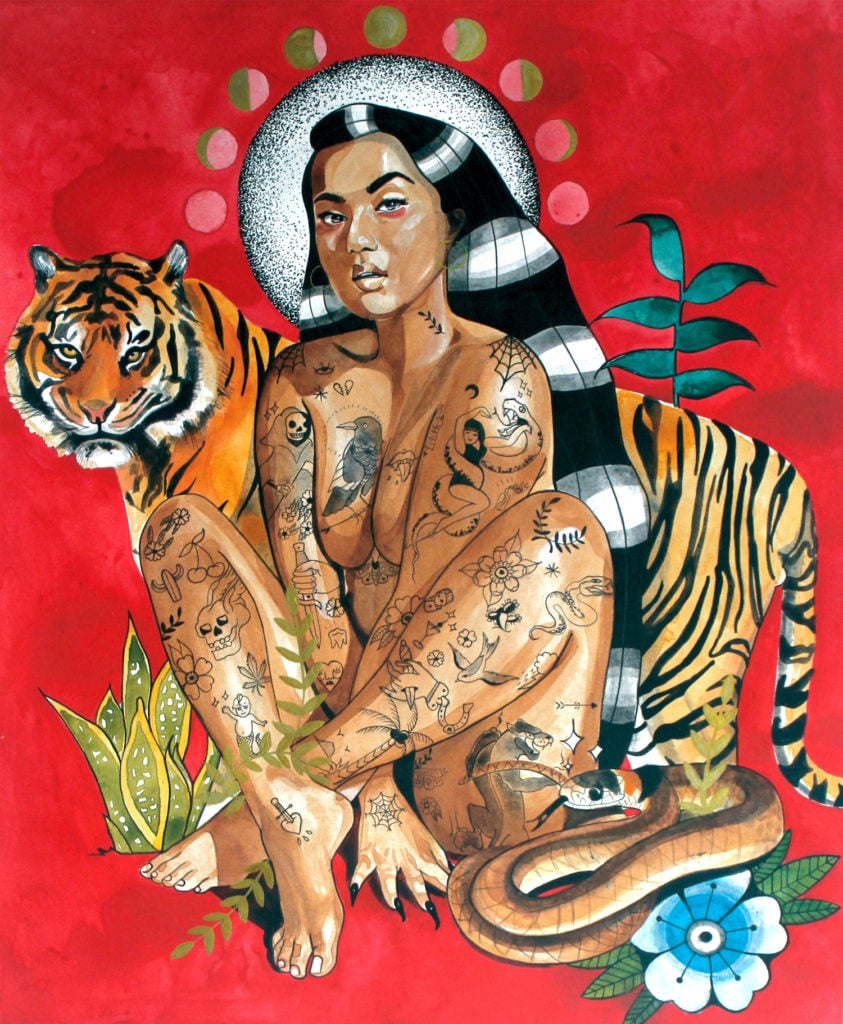
Elizabeth Barreto, Lilith. Image courtesy Elizabeth Barreto.
Barreto, who splits her time between San Juan and Mexico City, creates fierce illustrations of Puerto Rican and Mexican women (as well as feminist icons like the cartoon character Lisa Simpson). “To present this show in an all femme studio/workshop is an opportunity to rectify women’s misrepresentation and also to support local art production by women artists,” Barreto wrote via email later. “Amplifying what MECA had to offer, the local art community proved what we’re capable of.”
Pública, a sleek new space that launched just as MECA art week kicked-off, offered two photography-focused exhibits. One was the Natalia Viera-curated “La Ruta del Progreso,” featuring art by Christopher Gregory, Natalia Lasalle-Morillo, and Erika P. Rodríguez, centered on the Puerto Rican landscape. Alongside it was “Our Mind; A Weapon,” by Gabi Pérez Silver, a series on mental health.
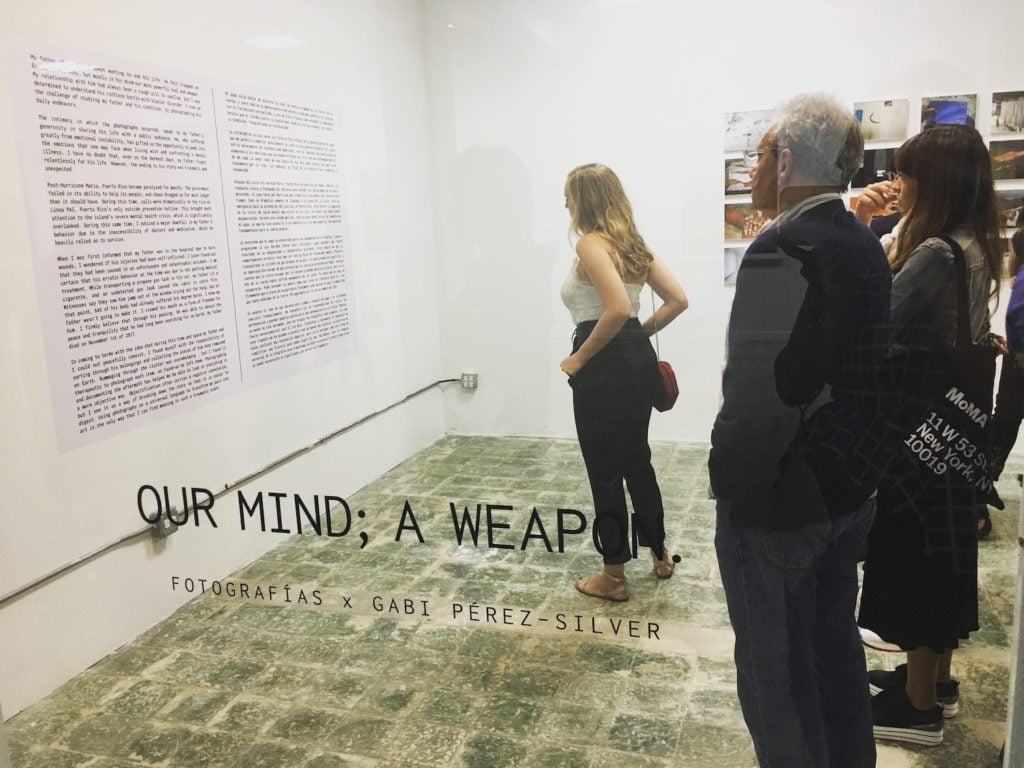
The opening of “Our Mind; A Weapon” by Gabi Pérez Silver at Pública. Image courtesy Pública.
“With these exhibitions we were able to expose our commitment to social, political, and human reflection,” Pública’s executive drector Naima Rodríguez, offers over email. “I think it was a good representation of what the programming of the space will be.”
Meanwhile, in Old San Juan, at La Casa de los Contrafuertes, which is both a pharmacy museum and an art gallery, the Spanish hacienda-like building housed a rich and profound exhibition called “Haiti Aqui,” which examines the cultural exchange between Haitians and Puerto Ricans.
On Calle Fortaleza, the eclectic space Souvenir 154 shows both edgy art and sells chic design objects by local creatives. Visitors can pick up limited-edition towels inspired by the Puerto Rican rum brand Don Q, by veteran artist and San Juan native Enoc Perez.
“I’ve never seen so many spaces in Old San Juan and in Santurce activated at the same time,” Báez told me. “I will say the marriage between MECA and the local art scene is starting to grow… The way that this edition of MECA has impacted the local scene for artists is humongous. We have to deal with people fighting for openings—who’s getting what day. The marriage is great and now everybody wants to sleep with us.”
Though all this might seem insignificant with the headlines about Hurricane Maria’s impact still lingering, on a local level, MECA art week delivers a slight economic boost as well. Ubers are requested, hotel rooms are booked, people eat at food trucks during the fair, or dine in San Juan’s many restaurants afterwards. “Cuatro Sombras [a local cafe in Old San Juan] has been the busiest coffee shop in Old San Juan in the past five days,” Báez claimed.
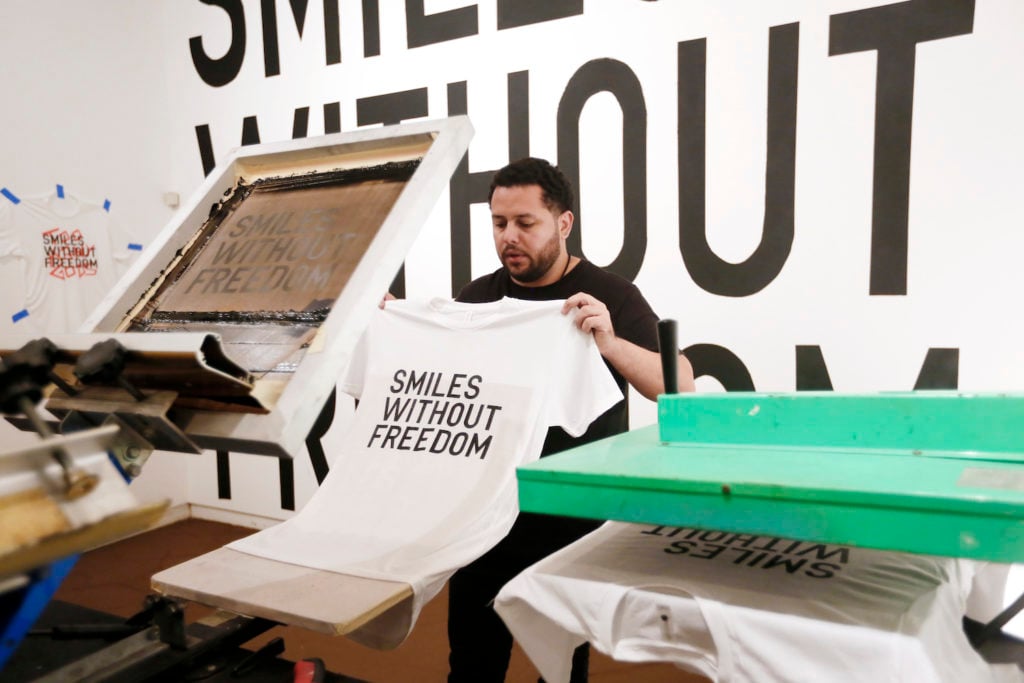
Live screenprinting at the Medalla Fresh Art section of MECA art fair. Image courtesy MECA.
“Local businesses, artists and their satellite programming—everyone notices that impact,” Rodríguez said. And it was not just the ultra high-end, either, he added, pointing to the impact on everyone “from the bartender to the bakery owner on the corner.”
The fair is just getting started, but it’s off to a promising start. It seems possible that MECA will achieve its goal, of becoming a mecca for contemporary art in the Caribbean.